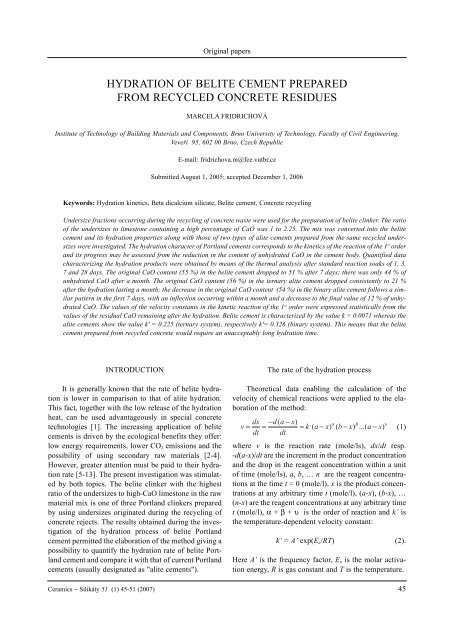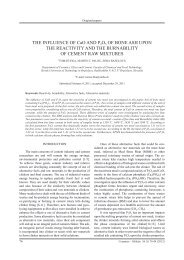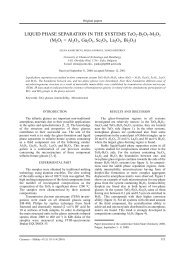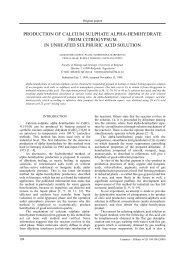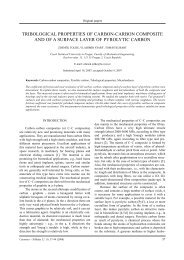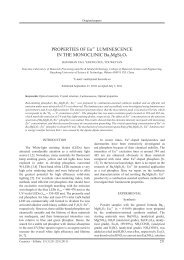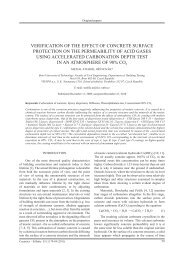hydration of belite cement prepared from ... - Ceramics-Silikaty
hydration of belite cement prepared from ... - Ceramics-Silikaty
hydration of belite cement prepared from ... - Ceramics-Silikaty
You also want an ePaper? Increase the reach of your titles
YUMPU automatically turns print PDFs into web optimized ePapers that Google loves.
Original papers<br />
HYDRATION OF BELITE CEMENT PREPARED<br />
FROM RECYCLED CONCRETE RESIDUES<br />
MARCELA FRIDRICHOVÁ<br />
Institute <strong>of</strong> Technology <strong>of</strong> Building Materials and Components, Brno University <strong>of</strong> Technology, Faculty <strong>of</strong> Civil Engineering,<br />
Veveøí 95, 602 00 Brno, Czech Republic<br />
E-mail: fridrichova.m@fce.vutbr.cz<br />
Submitted August 1, 2005; accepted December 1, 2006<br />
Keywords: Hydration kinetics, Beta dicalcium silicate, Belite <strong>cement</strong>, Concrete recycling<br />
Undersize fractions occurring during the recycling <strong>of</strong> concrete waste were used for the preparation <strong>of</strong> <strong>belite</strong> clinker. The ratio<br />
<strong>of</strong> the undersizes to limestone containing a high percentage <strong>of</strong> CaO was 1 to 2.25. The mix was converted into the <strong>belite</strong><br />
<strong>cement</strong> and its <strong>hydration</strong> properties along with those <strong>of</strong> two types <strong>of</strong> alite <strong>cement</strong>s <strong>prepared</strong> <strong>from</strong> the same recycled undersizes<br />
were investigated. The <strong>hydration</strong> character <strong>of</strong> Portland <strong>cement</strong>s corresponds to the kinetics <strong>of</strong> the reaction <strong>of</strong> the 1 st order<br />
and its progress may be assessed <strong>from</strong> the reduction in the content <strong>of</strong> unhydrated CaO in the <strong>cement</strong> body. Quantified data<br />
characterizing the <strong>hydration</strong> products were obtained by means <strong>of</strong> the thermal analysis after standard reaction soaks <strong>of</strong> 1, 3,<br />
7 and 28 days. The original CaO content (55 %) in the <strong>belite</strong> <strong>cement</strong> dropped to 51 % after 7 days; there was only 44 % <strong>of</strong><br />
unhydrated CaO after a month. The original CaO content (56 %) in the ternary alite <strong>cement</strong> dropped consistently to 21 %<br />
after the <strong>hydration</strong> lasting a month; the decrease in the original CaO content (54 %) in the binary alite <strong>cement</strong> follows a similar<br />
pattern in the first 7 days, with an inflection occurring within a month and a decrease to the final value <strong>of</strong> 12 % <strong>of</strong> unhydrated<br />
CaO. The values <strong>of</strong> the velocity constants in the kinetic reaction <strong>of</strong> the 1 st order were expressed statistically <strong>from</strong> the<br />
values <strong>of</strong> the residual CaO remaining after the <strong>hydration</strong>. Belite <strong>cement</strong> is characterized by the value k = 0.0071 whereas the<br />
alite <strong>cement</strong>s show the value k' = 0.225 (ternary system), respectively k'= 0.326 (binary system). This means that the <strong>belite</strong><br />
<strong>cement</strong> <strong>prepared</strong> <strong>from</strong> recycled concrete would require an unacceptably long <strong>hydration</strong> time.<br />
INTRODUCTION<br />
It is generally known that the rate <strong>of</strong> <strong>belite</strong> <strong>hydration</strong><br />
is lower in comparison to that <strong>of</strong> alite <strong>hydration</strong>.<br />
This fact, together with the low release <strong>of</strong> the <strong>hydration</strong><br />
heat, can be used advantageously in special concrete<br />
technologies [1]. The increasing application <strong>of</strong> <strong>belite</strong><br />
<strong>cement</strong>s is driven by the ecological benefits they <strong>of</strong>fer:<br />
low energy requirements, lower CO 2 emissions and the<br />
possibility <strong>of</strong> using secondary raw materials [2-4].<br />
However, greater attention must be paid to their <strong>hydration</strong><br />
rate [5-13]. The present investigation was stimulated<br />
by both topics. The <strong>belite</strong> clinker with the highest<br />
ratio <strong>of</strong> the undersizes to high-CaO limestone in the raw<br />
material mix is one <strong>of</strong> three Portland clinkers <strong>prepared</strong><br />
by using undersizes originated during the recycling <strong>of</strong><br />
concrete rejects. The results obtained during the investigation<br />
<strong>of</strong> the <strong>hydration</strong> process <strong>of</strong> <strong>belite</strong> Portland<br />
<strong>cement</strong> permitted the elaboration <strong>of</strong> the method giving a<br />
possibility to quantify the <strong>hydration</strong> rate <strong>of</strong> <strong>belite</strong> Portland<br />
<strong>cement</strong> and compare it with that <strong>of</strong> current Portland<br />
<strong>cement</strong>s (usually designated as "alite <strong>cement</strong>s").<br />
The rate <strong>of</strong> the <strong>hydration</strong> process<br />
Theoretical data enabling the calculation <strong>of</strong> the<br />
velocity <strong>of</strong> chemical reactions were applied to the elaboration<br />
<strong>of</strong> the method:<br />
dx da x<br />
v = = − ( − ) , α β υ<br />
= k ( a−x) ( b−x) ...( a−x)<br />
(1)<br />
dt dt<br />
where v is the reaction rate (mole/ls), dx/dt resp.<br />
-d(a-x)/dt are the increment in the product concentration<br />
and the drop in the reagent concentration within a unit<br />
<strong>of</strong> time (mole/ls), a, b, … n are the reagent concentrations<br />
at the time t = 0 (mole/l), x is the product concentrations<br />
at any arbitrary time t (mole/l), (a-x), (b-x), …<br />
(n-x) are the reagent concentrations at any arbitrary time<br />
t (mole/l), α + β + υ is the order <strong>of</strong> reaction and k’ is<br />
the temperature-dependent velocity constant:<br />
k’ = A’ exp(E a /RT) (2).<br />
Here A’ is the frequency factor, E a is the molar activation<br />
energy, R is gas constant and T is the temperature.<br />
<strong>Ceramics</strong> − Silikáty 51 (1) 45-51 (2007) 45
Fridrichová M.<br />
An analogous description can be also proposed for<br />
the <strong>hydration</strong> <strong>of</strong> Portland <strong>cement</strong>s where the content <strong>of</strong><br />
not yet hydrated CaO represents a reagent that characterizes<br />
the <strong>hydration</strong> conditions with a sufficient accuracy<br />
and which can be quantified with a rather good<br />
accuracy at the same time. It was demonstrated experimentally<br />
(see below) that, under standard laboratory<br />
exposure (T = constant, w = constant), the decrement in<br />
the not yet hydrated CaO can be described by means <strong>of</strong><br />
an exponential dependence, i.e. with a kinetic reaction<br />
<strong>of</strong> the 1 st order:<br />
dx<br />
= k , a−x<br />
(3)<br />
dt<br />
( )<br />
The separation <strong>of</strong> variables and the subsequent<br />
integration yield the following expression:<br />
(a - x) = ae -k’t (4)<br />
Under constant exposure conditions, the equation<br />
(4) also controls the <strong>cement</strong> <strong>hydration</strong>; this process can<br />
be described by the following expression:<br />
CaO t - CaO 0 ae -kt (5)<br />
where CaO t is the content <strong>of</strong> not yet hydrated CaO in<br />
the <strong>cement</strong> stone at the <strong>hydration</strong> time t (%) and CaO 0<br />
is the CaO content in the <strong>cement</strong> paste at the beginning<br />
<strong>of</strong> the <strong>hydration</strong> at the time t = 0 (%).<br />
The content <strong>of</strong> not yet hydrated calcium oxide<br />
(CaO t ) was quantified by calculation as a difference<br />
between the content <strong>of</strong> calcium oxide in the <strong>cement</strong><br />
paste at the beginning <strong>of</strong> the <strong>hydration</strong> (CaO 0 ) and that<br />
<strong>of</strong> CaO which corresponds to individual <strong>hydration</strong> products<br />
at the given exposure time (CaO h ):<br />
CaO t = CaO 0 - CaO h (6)<br />
For the determination <strong>of</strong> the CaO 0 value, the total<br />
content <strong>of</strong> calcium oxide in the given <strong>cement</strong> sample<br />
(CaO cem ) was taken as the basic value. It was always recalculated<br />
by taking into account the state <strong>of</strong> the respective<br />
<strong>cement</strong> paste at the given time <strong>of</strong> <strong>hydration</strong> by<br />
using the expression for the total loss-on-ignition ∑ LOI<br />
(determined by thermal analysis):<br />
CaO<br />
0<br />
= CaO<br />
cem<br />
−∑<br />
100 LOI<br />
100<br />
(7)<br />
The total amount <strong>of</strong> calcium oxide in the <strong>hydration</strong><br />
products CaO h <strong>of</strong> the <strong>cement</strong> paste was calculated with<br />
the aid <strong>of</strong> the thermal analysis. The CaO content corresponding<br />
to hydroxide, respectively to calcium carbonate<br />
(CaO p+k ) was expressed <strong>from</strong> the loss-on-ignition shown<br />
on the TG curve in the temperature range <strong>of</strong> 400-600°C<br />
(for Ca(OH) 2 ) and in the range <strong>of</strong> 600-1000°C for<br />
CaCO 3 . The CaO content corresponding to calcium<br />
hydrosilicates (CaO C–S–H ) was calculated <strong>from</strong> the CaO<br />
content in the hydroxide, respectively in calcium carbonate<br />
by using stoichiometric computations made possible<br />
by following equations:<br />
2C 3 S + 6H 2 O → C 3 S 2 H 3 + 3Ca(OH) 2 (8)<br />
2C 2 S + 4H 2 O → C 3 S 2 H 3 + Ca(OH) 2 (9)<br />
which means that the CaO content corresponding to<br />
afwillite (C 3 S 2 H 3 ) in the alite <strong>cement</strong> is the same as that<br />
corresponding to hydroxide and calcium carbonate;<br />
however, it is three times larger in the <strong>belite</strong> <strong>cement</strong>.<br />
The CaO content corresponding to alumino-calcium<br />
hydrosulfonates, represented here by ettringite (CaO E ),<br />
was expressed by stoichiometric computation <strong>from</strong> the<br />
loss-on-ignition on the TG curve in the temperature<br />
range <strong>of</strong> 100-300°C after subtracting the loss-on-ignition<br />
due to the de<strong>hydration</strong> <strong>of</strong> the above quantified<br />
afwillite. The total content <strong>of</strong> calcium oxide in the<br />
<strong>hydration</strong> products <strong>of</strong> the <strong>cement</strong> paste (CaO h ) then represents<br />
the sum <strong>of</strong> all above partial contents:<br />
CaO h = CaO p+k + CaO C–S–H + CaO E (10)<br />
EXPERIMENTAL<br />
Undersizes occurring in the treatment <strong>of</strong> recycled<br />
concrete rejects were used for the preparation <strong>of</strong> <strong>belite</strong><br />
Portland clinker as one <strong>of</strong> the component <strong>of</strong> raw material<br />
powder mix because this fraction contains suitable<br />
oxides, respectively minerals even if in a somewhat different<br />
quantitative representation: the SiO 2 content is<br />
higher to the detriment <strong>of</strong> the CaO content (SiO 2 usually<br />
occurs as quartz). As regards the occurrence <strong>of</strong> other<br />
hydraulic and non-hydraulic oxides it is already more or<br />
less the same as that in the usual raw material mix used<br />
for firing Portland clinkers. The proposed compositional<br />
set-up <strong>of</strong> the powder mix for the <strong>belite</strong> clinker was<br />
characterized by the ratio <strong>of</strong> recycled concrete undersizes<br />
to the high-CaO limestone; it amounted to 1 : 2.25.<br />
Also two more mixes aimed at obtaining comparable<br />
alite clinkers with the ratio <strong>of</strong> 1 : 3.5 were <strong>prepared</strong><br />
(2% Fe correction was made for the second one). All<br />
three clinkers were fired in an experimental rotary kiln<br />
under firing conditions typical for Portland clinker.<br />
The above-mentioned firing yielded three clinkers:<br />
a binary alite clinker (designated by A - 0 % Fe), ternary<br />
alite clinker (designated by A - 2 % Fe) and a binary<br />
<strong>belite</strong> clinker (designated by B - 0 % Fe). Their phase<br />
composition was determined with the aid <strong>of</strong> the method<br />
<strong>of</strong> microscopic point integration (see Table 1).<br />
The clinkers were then ground with a 5% addition<br />
<strong>of</strong> gypsum to obtain <strong>cement</strong>s with the specific surface<br />
area <strong>of</strong> 300 m 2 /kg. The <strong>cement</strong>s were used for the preparation<br />
<strong>of</strong> pastes characterized by the water coefficient <strong>of</strong><br />
46 <strong>Ceramics</strong> − Silikáty 51 (1) 45-51 (2007)
Hydration <strong>of</strong> <strong>belite</strong> <strong>cement</strong> <strong>prepared</strong> <strong>from</strong> recycled concrete residues<br />
w = 0.30. The pastes were hydrated in aqueous environment.<br />
The samples used for the determination <strong>of</strong> the<br />
mineralogical composition were taken after 1, 3, 7 and<br />
28 days <strong>of</strong> <strong>hydration</strong>.<br />
Table 1. Quantification <strong>of</strong> the phase composition <strong>of</strong> Portland<br />
clinkers.<br />
Clinker Designation<br />
Phase (%) A - 0 % Fe A - 2 % Fe B - 0 % Fe<br />
C 3 S 51.1 48.7 0.0<br />
C 2 S 35.7 36.9 85.9<br />
C 3 A 10.9 3.8 10.1<br />
C 4 AF 1.8 10.2 4.0<br />
C vol 0.5 0.4 0.0<br />
Total 100.0 100.0 100.0<br />
RESULTS AND DISCUSSION<br />
RTG diffraction analysis<br />
Residues <strong>of</strong> original clinker minerals as well as<br />
new <strong>hydration</strong> products were determined by XRD<br />
analysis <strong>of</strong> hydrated <strong>cement</strong> pastes:<br />
- the alite, C 3 S (d h,k,l = 0.59; 0.296; 0.278; 0.274 nm)<br />
- the <strong>belite</strong>, C 2 S (d h,k,l = 0.296; 0.278; 0.274; 0.2405 nm)<br />
- the brownmillerite, C 4 AF (d h,k,l = 0.724; 0.277 nm)<br />
- the portlandite, Ca(OH) 2 (d h,k,l = 0.492; 0.3112;<br />
0.2628 nm)<br />
- the calcite, CaCO 3 (d h,k,l = 0.386; 0.3035 nm)<br />
- the ettringite, C 3 A·3CaSO 4·32H 2 O (d h,k,l = 0.98; 0.57;<br />
0.387 nm)<br />
- the mono-sulfate, C 3 A·CaSO 4·12H 2 O (d h,k,l = 0.892 nm)<br />
- the CSH n (d h,k,l = 0.305 nm).<br />
The character <strong>of</strong> diffraction patterns <strong>of</strong> all samples<br />
corresponds to usual qualitative data typical for Portland<br />
clinkers; therefore, it is not mentioned below.<br />
Thermal analysis<br />
The qualitative evaluation based on the DTA curve<br />
was performed in the same manner for all three samples<br />
after all exposure times. The first endothermic peak at a<br />
temperature <strong>of</strong> 150° C in the temperature range <strong>of</strong> up to<br />
300°C corresponded to the de<strong>hydration</strong> <strong>of</strong> calcium<br />
hydrosilicates and ettringite. Then, a predominantly<br />
shallow endothermic region attaining its maximum<br />
value at about 480°C and corresponding to the dehydroxylation<br />
<strong>of</strong> calcium hydroxide followed after a short<br />
indifferent region starting at approximately 400°C. At a<br />
temperature <strong>of</strong> 600°C this peak passed into an endothermic<br />
region characterizing the decomposition <strong>of</strong> calcium<br />
carbonate with a maximum at 820°C.<br />
The investigated phases were quantified using the<br />
TG and DTG curves in the following way:<br />
The CaO content corresponding to calcium hydroxide<br />
originated in result <strong>of</strong> the <strong>hydration</strong> <strong>of</strong> calcium silicates<br />
as well as CaO corresponding to calcium carbonate<br />
formed secondarily <strong>from</strong> calcium hydroxide (%):<br />
56<br />
56 100<br />
CaO (11)<br />
p+ k= ( LOI400−600 + LOI600−900)<br />
18<br />
44 m<br />
where LOI 400-600 is the Loss-on-ignition corresponding to<br />
the dehydroxylation <strong>of</strong> Ca(OH) 2 (mg), LOI 600-900 is the<br />
Loss-on-ignition corresponding to the decomposition <strong>of</strong><br />
CaCO 3 (mg), m is the sample mass (mg).<br />
The water content corresponding to the de<strong>hydration</strong><br />
<strong>of</strong> calcium hydrosilicates, H 2 O C–S–H (mg): the quantification<br />
<strong>of</strong> the <strong>hydration</strong> products originated <strong>from</strong> alite and<br />
<strong>belite</strong> was based on the mentioned Equations (8) and (9)<br />
because the afwillite (C 3 S 2 H 3 ) characterizes very accurately<br />
the stoichiometry <strong>of</strong> calcium hydrosilicate phases.<br />
Therefore, the water contained in these products<br />
can be calculated by using the following expressions:<br />
a) for the alite<br />
18 m<br />
H<br />
2OC−S− H= CaOCa( OH) (mg)<br />
2<br />
56 100<br />
b) for the <strong>belite</strong><br />
18 m<br />
H<br />
2OC−S− H= 3CaOCa( OH) (mg)<br />
2<br />
56 100<br />
(12)<br />
(13)<br />
Although both alite <strong>cement</strong>s also contained the<br />
<strong>belite</strong>, it was shown that its presence may be neglected<br />
in the binary <strong>cement</strong>. However, the content <strong>of</strong> this phase<br />
in the ternary <strong>cement</strong> was already significant and, hence,<br />
it could not be neglected in the calculation made for the<br />
exposure time lasting 28 days. Therefore, in this case,<br />
the CaO content was split up into hydroxide, respectively<br />
calcium carbonate by taking into account the relative<br />
occurrence <strong>of</strong> both aforementioned clinker minerals.<br />
The water content corresponding to the de<strong>hydration</strong><br />
<strong>of</strong> ettringite, H 2 O E [mg]: owing to the fact that the first<br />
endothermic peak in the range <strong>of</strong> up to 300°C shows the<br />
loss-on-ignition corresponding only to the de<strong>hydration</strong><br />
<strong>of</strong> calcium hydrosilicates and ettringite, the loss-onignition<br />
corresponds - after subtracting water due to the<br />
afwillite - to water released by the ettringite:<br />
H 2 O E = LOI 0-300 - H 2 O C–S–H (14)<br />
where LOI 0-300 …the loss-on-ignition corresponding to<br />
the decomposition <strong>of</strong> C–S–H phases and ettringite (mg).<br />
The CaO content corresponding to calcium hydrosilicates<br />
(%). Using the stoichiometric formulae this<br />
content was calculated <strong>from</strong> the amount <strong>of</strong> water corresponding<br />
to the afwillite de<strong>hydration</strong>:<br />
CaO<br />
56 100<br />
= H 2<br />
O<br />
− −<br />
18 m<br />
C−S−H C S H<br />
(15)<br />
<strong>Ceramics</strong> − Silikáty 51 (1) 45-51 (2007) 47
Fridrichová M.<br />
The CaO content corresponding to alumino-calcium<br />
hydrosulfonates represented by the ettringite CaO E (%).<br />
It was obtained by stoichiometric calculation <strong>from</strong> the<br />
loss-on-ignition corresponding to the water released<br />
during the <strong>hydration</strong> <strong>of</strong> the ettringite:<br />
6 56 100<br />
CaOE<br />
= H 2<br />
OE<br />
(16)<br />
32 18 m<br />
The total CaO content in the <strong>hydration</strong> products <strong>of</strong><br />
the <strong>cement</strong> paste (CaO H ) represents a sum <strong>of</strong> all the<br />
above described portions <strong>of</strong> calcium oxide:<br />
CaO H = CaO p+k + CaO C–S–H + CaO E (17)<br />
The calculated values <strong>of</strong> calcium oxide corresponding<br />
to individual <strong>hydration</strong> products including the total<br />
content <strong>of</strong> calcium oxide in the <strong>hydration</strong> products<br />
(CaO H ) are given in Table 2 for the individual <strong>hydration</strong><br />
periods.<br />
The contents <strong>of</strong> not yet hydrated calcium oxide<br />
(CaO t ) corresponding to the individual periods <strong>of</strong><br />
<strong>hydration</strong> (Table 3) and their graphical representations<br />
(Figures 1-3) were obtained on the basis <strong>of</strong> the CaO H<br />
values shown in Table 2 and <strong>from</strong> the content <strong>of</strong> calcium<br />
oxide determined in the respective <strong>cement</strong> by means<br />
<strong>of</strong> a chemical analysis as well as on the basis <strong>of</strong> the TA<br />
values converted to the CaO content in the given state<br />
<strong>of</strong> the <strong>cement</strong> paste.<br />
DTA curves <strong>of</strong> hydrated <strong>cement</strong> pastes after the<br />
exposure periods <strong>of</strong> 1, 3, 7 and 28 days are represented<br />
in Figures 4-6.<br />
Application <strong>of</strong> the equation for the calculation<br />
<strong>of</strong> the reaction rate <strong>of</strong> Portland <strong>cement</strong> <strong>hydration</strong><br />
Using numerical methods the Equation (5) was<br />
modified ; the values characterizing the content <strong>of</strong> not<br />
yet hydrated calcium oxide (CaO t ) and the respective<br />
<strong>hydration</strong> time shown in Table 2 were applied to this<br />
purpose. The following specific expressions could thus<br />
be obtained for individual types <strong>of</strong> <strong>cement</strong>:<br />
- binary alite <strong>cement</strong> A - 0 % Fe: CaO t = 75.8·e -0.326.t ,<br />
- ternary alite <strong>cement</strong> A - 2 % Fe: CaO t = 68.7·e -0.225.t ,<br />
- binary <strong>belite</strong> <strong>cement</strong> B - 0 % Fe: CaO t = 53.1·e -0.0071.t .<br />
In addition to the fact that the initial CaO 0 content<br />
calculated experimentally in the <strong>cement</strong> paste drops in<br />
dependence on the <strong>belite</strong> content (as actually observed<br />
in the practice) it is also evident <strong>from</strong> the respective<br />
velocity constants that the reaction rate <strong>of</strong> the Portland<br />
<strong>cement</strong> <strong>hydration</strong> decreases the more, the less alite the<br />
<strong>cement</strong> contains.<br />
Table 3. Quantification <strong>of</strong> unhydrated CaO.<br />
Duration <strong>of</strong> Content on unhydrated CaO t (%)<br />
Hydration (days) A - 0 % Fe A - 2 % Fe B - 0 % Fe<br />
0 53.55 55.69 54.42<br />
1 34.11 45.47 51.65<br />
3 32.49 33.25 51.17<br />
7 26.84 30.28 51.12<br />
28 11.84 21.35 43.47<br />
Table 2. CaO content in <strong>hydration</strong> products.<br />
Duration <strong>of</strong> <strong>hydration</strong><br />
A - 0 % FeO<br />
(days) CaO p+k (%) CaO C–S–H (%) CaO E (%) CaO H (%)<br />
1 8.6 8.6 2.2 19.4<br />
3 10.3 10.3 3.0 23.6<br />
7 11.6 11.6 3.8 27.0<br />
28 15.6 19.3 4.1 39.0<br />
Duration <strong>of</strong> <strong>hydration</strong><br />
A - 2 % FeO<br />
(days) CaO p+k (%) CaO C–S–H (%) CaO E (%) CaO H (%)<br />
1 7.1 7.1 0.8 15.0<br />
3 9.9 9.9 2.6 22.4<br />
7 10.4 10.4 3.2 24.0<br />
28 11.8 15.2 4.0 31.0<br />
Duration <strong>of</strong> <strong>hydration</strong><br />
B - 0 % FeO<br />
(days) CaO p+k (%) CaO C–S–H (%) CaO E (%) CaO H (%)<br />
1 1.1 3.3 0.6 5.0<br />
3 1.3 3.9 0.4 5.6<br />
7 1.2 3.6 0.8 5.6<br />
28 3.2 9.6 0.6 13.4<br />
48 <strong>Ceramics</strong> − Silikáty 51 (1) 45-51 (2007)
Hydration <strong>of</strong> <strong>belite</strong> <strong>cement</strong> <strong>prepared</strong> <strong>from</strong> recycled concrete residues<br />
CONCLUSION<br />
The minimum time <strong>of</strong> <strong>hydration</strong> <strong>of</strong> investigated<br />
<strong>cement</strong>s that is particularly important <strong>from</strong> the viewpoint<br />
<strong>of</strong> the envisaged use <strong>of</strong> <strong>belite</strong> <strong>cement</strong> was calculated<br />
for Portland <strong>cement</strong>s <strong>prepared</strong> on the basis <strong>of</strong> recycled<br />
concrete rejects by using the proposed method<br />
based on the calculation <strong>of</strong> the reaction rate <strong>of</strong> the<br />
<strong>hydration</strong> process.<br />
endo<br />
60<br />
50<br />
0 100 200 300 400 500 600 700 800 900 1000<br />
Temperature (°C)<br />
1 day<br />
CaO t<br />
(%)<br />
40<br />
30<br />
20<br />
10<br />
endo<br />
0<br />
60<br />
50<br />
0 5 10 15 20 25 30<br />
Days<br />
Figure 1. Content <strong>of</strong> unhydrated CaO t vs. <strong>hydration</strong> time.<br />
A - 0 % Fe.<br />
0 100 200 300 400 500 600 700 800 900 1000<br />
Temperature (°C)<br />
3 days<br />
CaO t<br />
(%)<br />
40<br />
30<br />
20<br />
endo<br />
10<br />
0<br />
0 5 10 15 20 25 30<br />
Days<br />
Figure 2. Content <strong>of</strong> unhydrated CaO t vs. <strong>hydration</strong> time.<br />
A - 2 % Fe.<br />
0 100 200 300 400 500 600 700 800 900 1000<br />
Temperature (°C)<br />
7 days<br />
CaO t<br />
(%)<br />
60<br />
50<br />
40<br />
30<br />
20<br />
10<br />
endo<br />
0<br />
0 5 10 15 20 25 30<br />
Days<br />
Figure 3. Content <strong>of</strong> unhydrated CaO t vs. <strong>hydration</strong> time.<br />
B - 0 % Fe.<br />
0 100 200 300 400 500 600 700 800 900 1000<br />
Temperature (°C)<br />
28 days<br />
Figure 4. DTA <strong>of</strong> hydrated <strong>cement</strong> A - 0 % Fe.<br />
<strong>Ceramics</strong> − Silikáty 51 (1) 45-51 (2007) 49
Fridrichová M.<br />
endo<br />
0 100 200 300 400 500 600 700 800 900 1000<br />
Temperature (°C)<br />
1 day<br />
0 100 200 300 400 500 600 700 800 900 1000<br />
Temperature (°C)<br />
1 day<br />
endo<br />
0 100 200 300 400 500 600 700 800 900 1000<br />
Temperature (°C)<br />
3 days<br />
endo<br />
0 100 200 300 400 500 600 700 800 900 1000<br />
Temperature (°C)<br />
7 days<br />
endo<br />
endo<br />
endo<br />
0 100 200 300 400 500 600 700 800 900 1000<br />
Temperature (°C)<br />
3 days<br />
endo<br />
0 100 200 300 400 500 600 700 800 900 1000<br />
Temperature (°C)<br />
7 days<br />
endo<br />
0 100 200 300 400 500 600 700 800 900 1000<br />
Temperature (°C)<br />
28 days<br />
Figure 5. DTA <strong>of</strong> hydrated <strong>cement</strong> A - 2 % Fe.<br />
0 100 200 300 400 500 600 700 800 900 1000<br />
Temperature (°C)<br />
28 days<br />
Figure 6. DTA <strong>of</strong> hydrated <strong>cement</strong> B - 0 % Fe.<br />
50 <strong>Ceramics</strong> − Silikáty 51 (1) 45-51 (2007)
Hydration <strong>of</strong> <strong>belite</strong> <strong>cement</strong> <strong>prepared</strong> <strong>from</strong> recycled concrete residues<br />
The calculated time <strong>of</strong> <strong>hydration</strong> is unacceptably<br />
long for <strong>prepared</strong> <strong>belite</strong> Portland <strong>cement</strong>. The future<br />
investigation should focus the possibility to modify the<br />
<strong>belite</strong> Portland <strong>cement</strong> <strong>prepared</strong> <strong>from</strong> recycled concrete<br />
rejects in such a way that should bring the acceleration<br />
<strong>of</strong> the <strong>hydration</strong> process.<br />
References<br />
1. Jinyu L., et al.: J.Chin.Ceram.Soc. 32, 364 (2004).<br />
2. Fa-Tang L., et al.: Hebei J.Indus.Sci.Tech. 20, 57<br />
(2003).<br />
3. Popescu C. D., et al.: Cem.Concr.Comp. 25, 689<br />
(2003).<br />
4. Guerrero A., et al.: Envir.Sci.Tech. 38, 3209 (2004).<br />
5. Šatava V.: Physical Chemistry <strong>of</strong> Silicates, ICT Prague,<br />
Prague 1991.<br />
6. Young-Min K., Seong-Hyeon H.: J.Am.Ceram.Soc. 87,<br />
900 (2004).<br />
7. Richardson I.G.: Cem.Concr.Res. 34, 1733 (2004).<br />
8. Nakshatra S. B., et al.: J.Am.Ceram.Soc. 85, 2171<br />
(2002).<br />
9. Black L., et al.: Cem.Concr.Res. 33, 1561 (2003).<br />
10. Livingston R. A.: Trans.Am.Nucl.Soc. 87, 486 (2002).<br />
11. Hela R.: Proc. Our World in Concrete and Structures.<br />
Singapore 2003.<br />
12. Fridrichová M., Fenrich J.: Cement International,<br />
Erkrath 2005.<br />
13. Fridrichová M.: Proc. XVII th Termanal, Slovak University<br />
<strong>of</strong> Technology, Bratislava 2005.<br />
HYDRATACE BELITICKÉHO CEMENTU<br />
PØIPRAVENÉHO Z RECYKLÁTÙ BETONU<br />
MARCELA FRIDRICHOVÁ<br />
Ústav technologie stavebních hmot a dílcù,<br />
Vysoké uèení technické v Brnì,<br />
Fakulta stavební,<br />
Veveøí 95, 602 00 Brno<br />
Pro pøípravu belitického slinku byly použity propady z<br />
výroby betonových recyklátù v pomìru 1 : 2,25 s vysokoprocentním<br />
vápencem. Po následném pøevedení na belitický<br />
<strong>cement</strong> studovány jeho hydrataèni vlastnosti paralelnì se<br />
dvìma typy alitických <strong>cement</strong>ù, pøipravených ze stejných<br />
recyklátových propadù. Prùbìh hydratace portlandských<br />
<strong>cement</strong>ù odpovídá kinetice reakce I. øádu a její postup lze sledovat<br />
ze snižování obsahu nezhydratovaného CaO t v <strong>cement</strong>ovém<br />
kameni. Hydrataèní produkty kvantifikovány pomocí<br />
termické analýzy po standartních reakèních prodlevách 1, 3, 7<br />
a 28 dnù. V belitickém <strong>cement</strong>u pùvodní obsah 55 % CaO klesal<br />
do 7 dnù na 51 % a po mìsíci jen na hodnotu 44 % nezhydratovaného<br />
CaO. V trojsložkovém alitickém <strong>cement</strong>u pùvodní<br />
CaO z 56 % klesá pravidelnì na 21 % po mìsíci hydratace, ve<br />
dvojsložkovém alitickém <strong>cement</strong>u pùvodní obsah 54 % CaO<br />
klesá obdobnì do 7 dnù se zlomem do 1 mìsíce až na koneènou<br />
hodnotu 12 % nezhydratovaného CaO. Z hodnot zbytkového<br />
CaO po hydrataci statisticky vyjádøeny hodnoty rychlostních<br />
konstant pro kinetickou rovnici I. øádu. Belitický <strong>cement</strong><br />
vykazuje hodnotu k´=0,0071, zatím co alitické <strong>cement</strong>y<br />
vykazují hodoty k´=0,225 pro trojsložkový, pøípadnì k´=0,326<br />
pro dvojsložkový <strong>cement</strong>, což znamená pro belitický <strong>cement</strong><br />
pøipravený z betonových recyklátù neúnosnì dlouhou dobu<br />
hydratace a je nutno jej modifikovat k urychlení tuhnutí.<br />
<strong>Ceramics</strong> − Silikáty 51 (1) 45-51 (2007) 51


